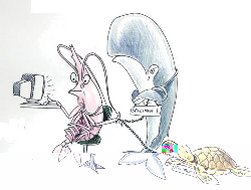|
















| |
 In England, people have a strong sense of identity with the coastal and
marine environment, from fish and chips, to a day on the beach, to a link
with the rest of the world. Living on an island is fundamental to our
national and cultural identity. England has a rich maritime history.
Many of the structures that identify our past and current relationship with
the sea (such as lighthouses, fishing villages, local harbours and piers)
remain intact, as a tangible reminder of our nautical heritage. In England, people have a strong sense of identity with the coastal and
marine environment, from fish and chips, to a day on the beach, to a link
with the rest of the world. Living on an island is fundamental to our
national and cultural identity. England has a rich maritime history.
Many of the structures that identify our past and current relationship with
the sea (such as lighthouses, fishing villages, local harbours and piers)
remain intact, as a tangible reminder of our nautical heritage.
The state of the maritime environment should matter to us all. At a global
level we rely on the sea to support ‘unseen’ processes such as those that
regulate the global climate. At a local level we depend on our coasts and
seas for resources such as fisheries and aggregates. The environment also
enriches our quality of life. One in three people live within 10 km of the
coast and many people look to our coasts and seas for inspiration and
relaxation1. This ‘hidden value’ is frequently overlooked in the economic
case for development, but it must be recognised that conservation has
social and financial benefits, as well as biodiversity gains. For example,
in 1998, 51% of people in England visited the seaside. Many of these
visitors will have spent money in the local economy. Recreational anglers, who share an interest in a healthy maritime
environment, are
estimated to be spending around £140 million each year in the coastal
economies of England and Wales.
A sustainable approach can also save
money. For example, an 80-metre broad band of saltmarsh in front of a
sea defence soaks up wave energy that would otherwise impact the
defence structures. This lowers the standard of defence needed, and can
save around £5 million per kilometre4. The World Bank estimates the
cost of environmentally sustainable management of the Mediterranean to
be half the cost of dealing with the consequences of mismanagement.
Prevention is better than cure, and more cost
effective. Remediation
required as a result of poor management is expensive.
A place of diversity
 Our coast is spectacular - from the granite coastline of
Cornwall, the
unique geology of the East Devon and Dorset World Heritage Site, the
world famous wetlands, saltmarshes and seabird communities of Norfolk
to the hauntingly beautiful sand dunes of the Northumbrian coast. But
many people do not realise the diversity and range of our coastal and
marine wildlife. England has an important mixture of maritime species
and habitats, influenced by the division between colder Arctic and
warmer Mediterranean waters around our shores. Dolphins, porpoises,
basking sharks and whales can all be seen around the coasts of England. Our coast is spectacular - from the granite coastline of
Cornwall, the
unique geology of the East Devon and Dorset World Heritage Site, the
world famous wetlands, saltmarshes and seabird communities of Norfolk
to the hauntingly beautiful sand dunes of the Northumbrian coast. But
many people do not realise the diversity and range of our coastal and
marine wildlife. England has an important mixture of maritime species
and habitats, influenced by the division between colder Arctic and
warmer Mediterranean waters around our shores. Dolphins, porpoises,
basking sharks and whales can all be seen around the coasts of England.
In addition our seas contain around another 40,000
species. This
complex of species provides the fundamental character to our marine ecosystems. Most of these species are completely hidden from view and
unknown to most people. Given the global, European and national
importance of our maritime ecosystems, society as a whole, and
Government in particular, must take responsibility to ensure the long term,
wise and sustainable use of this resource. This biodiversity includes
groups of animals that are almost entirely restricted to the marine
environment such as sponges, hydroids (sea-firs), sea anemones, bryozoans (sea-mats), echinoderms
(sea urchins, starfish and their relatives) and
ascidians (seasquirts). In fact, more than twice the number of major
animal groups (phyla) are found in England’s seas than on the land.
This diversity is largely founded upon the great variation of England’s
geology and geomorphology. Much of England’s coastline is designated wholly, or in
part, as Sites of Special Scientific Interest for its geology.
These cliff and foreshore sites contain exposures of rocks ranging in age
from 480 million years to the recent past (the last 10,000 years), where
they provide evidence for understanding change in the past, and indicate
what the future might hold.
|